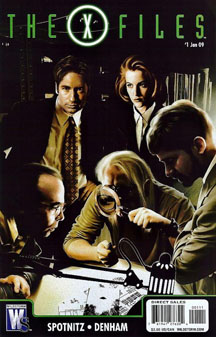Kicking off the second phase of the “X-Files” franchise, creator Chris Carter and fellow executive producer Frank Spotnitz were interested in checking in on Mulder and Scully’s relationship and job statuses in the 2008 movie “I Want to Believe.” However, they weren’t interested in continuing the mythology at that time, much to the consternation of many fans. The seven issues from Wildstorm Comics in the movie’s wake didn’t continue the story from Season 9 or from “I Want to Believe,” but rather told new stories set during the timeframe of the original series.
The upside is that whereas the showrunners’ involvement with the Topps comics was almost nonexistent, Carter and Spotnitz were involved with the Wildstorm comics, at least at the outset. In an interview in the back of Issue 0 (September 2008), Carter says: ” ‘The X-Files’ has proven to be such a flexible concept … the comic book is an opportunity to expand on that.” The undercurrent of that statement is that this is a canonical series, and the fact that Spotnitz writes Issues 0, 1 and 2 cinches that theory. Spotnitz adds that these tales are set roughly between Seasons 2 and 5.
Right off the bat, the most notable difference from the Topps series is the consistent moody darkness of the art by Brian Denham (pencils and inks) and Kelsey Shannon and Carlos Badilla (colors). Topps’ work was sometimes dark, but just as often done in the traditional four-color style. Like the Topps artists, Denham captures Mulder’s and Scully’s likenesses beautifully.
In Issue 0 (a new story in the old timeframe, despite the fact that the cover confusingly features the poster art from “I Want to Believe”), Spotnitz starts with a tale of a “missing woman (who) turns up after 17 years … not having aged a day,” as Mulder puts it. The agent makes no reference to the episode “Invocation” – which, granted, took place after this, during the Doggett days of Season 8 – nor to “Thin Air” (Topps Issue 17), about pilots who turn up unaged after a half-century. Ultimately, this tale ends up being extremely similar to the “Buffy” Season 2 episode “The Dark Age,” about a demon who jumps between different host bodies.
Spotnitz does a bang-up job on Issues 1-2 (January-February 2009), a pseudo-mythology two-parter. Perhaps feeling some regret over the Lone Gunmen’s deaths in Season 9, Spotnitz heavily features the trio as Mulder’s helpers here. The maguffin is a flash drive that contains no information but is covered with a deadly chemical that can be absorbed through the skin. In a delicious bit of dialogue, Langly at one point tells Scully “We don’t talk in front of The Man,” referring to Skinner. It’s a reminder that the Gunmen and Skinner didn’t cross paths too often before his appearance in the “Gunmen” TV series (although they did team up to assist Mulder in “Fight the Future”).

Spotnitz closes the story with a nicely pointed ending: Mulder succeeds in testifying before Congress about the deadly chemical, but rather than Congressmen rejecting this latest product of the military-industrial complex, they only become more enthusiastic about adding it to the military’s war arsenal.
For whatever reason, Spotnitz dropped out of the series and Marv Wolfman takes over for Issues 3-4. (Issue 4 claims this story takes place in 2009, but this is clearly a mistake, as – for one thing — M&S work for the FBI, and there are no references to the events of the 2008 movie.) As is sometimes the case with writers who are new to the saga, Wolfman has a tendency to overstate the believer-skeptic dynamic rather than just telling the story.
It’s a pretty good one, though, about a Chinese business mogul who seems to be a serial killer except that he has airtight alibis for all the killings. In classic “X-Files” fashion, the explanation is revealed somewhat offhandedly – completely identical human beings were created via an ancient “ceremony of simultaneously impregnation.” I like the way Wolfman taps into Chinese cultural lore, something that was also done with creepy effectiveness in the Season 3 episode “Hell Money.”
Doug Moench closes out the short-lived Wildstorm series with Issues 5-6, which reminded me a lot of the “Classic Star Wars” comics that were pasted together from newspaper strips. This is because of Moench’s conceits of 1) having Mulder narrate his explorations of caves beneath the South Dakota badlands to Scully on a tape recorder, and 2) having all the characters regularly say the names of the people they are speaking to.
Denham’s portrayal of the underground caverns adds a spooky vibe, but the story is the most standard of the Wildstorm batch. Also, the characters are the most off-point here. For example, Mulder is relatively calm despite being surrounded by fire, something that makes him freeze because of a phobia back in Season 1’s “Fire.” Granted, subsequent episodes don’t do a great job of remembering Mulder’s extreme fear of fire, but these issues ring particularly false.
In mid-2009, it seemed like “The X-Files” had petered out again. But a year later, Wildstorm still held the license, and the company made good use of it in a crossover with “30 Days of Night.” More on that in my next “X-Files” flashback.

